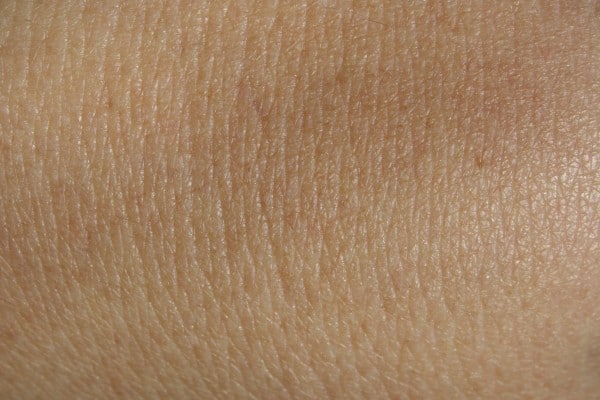skin types
Skin types are broken down by specific categories. These individual skin types are a natural combination of three factors:
- Water content (contributes to the level of the skin’s suppleness and comfort)
- Lipid content (contributes to nutrition and softness)
- Level of sensitivity (contributes to skin’s resistance and tolerance)
Normal Skin
Normal skin is achieved by the ideal balance between the rate of sebum production and cellular exchange.
Normal skin has barely visible pores and radiant complexion, with no blemishes or imperfections. Normal skin contains an adequate amount of water and lipids, an adequate balance between them, and a moderate sensitivity level.
Skin Types – Dry Skin
Dry skin is caused by genetic or hormonal aging, as well as external factors such as wind and UV radiation.
Dry skin has almost invisible pores, and a dull, rough complexion with red, flaky and/or “ashy” patches. Dry skin can sometimes also be normal. Alternately, this skin type is temporarily dry when exposed to external physical or chemical elements as well as pharmacologic factors. When the skin repairs itself after being exposed to these elements, dryness, itchiness and flaking usually occurs. Certain people suffer from genetic dry-skin conditions. Their skin doesn’t itch, but the disease causes their skin to flake and sometimes crack.
Skin Types – Very Dry Skin
Very dry skin is caused by genetic or hormonal aging, and external factors such as wind and UV radiation.
Very dry skin has almost invisible pores, and a dull, rough complexion with red, scaly, rough patches. The more severe, the more rough as scaly the texture and appearance. The outer skin layer may develop tiny cracks, mainly on the back of the hands, outer sides of the arms, forearms, and legs.
Skin Types – Normal, Combination Skin
Combination skin is caused by an imbalance in the production and distribution of lipids (due to hormonal and genetic factors).
The pores of normal, combination skin are overly dilated, tend to have blackheads and be shiny in the T-zone. The skin is either overly dry or excessively oily, with occasional roughness on the cheeks. The oiliness and dryness can change, too, depending on the time of year. Skin, of all types, is usually drier during prolonged exposure to cold weather. Even oily skin can become rough and irritated when exposed to a period of cold weather.
Skin Types – Oily Skin
Oily skin is caused by hyperactivity of the sebaceous glands that produce more oil than is needed due to puberty or other hormonal imbalances, stress, antibiotics, and exposure to heat or excessive humidity.
Oily skin can often be identified by dilated pores, shiny (sometimes “thick” looking) complexion, blackheads, and various degrees of acne. The oiliness of the skin can change on a sometimes daily basis. The changes in oily skin can be dependent on the type of climatic exposure. The oil glands produce excessive lipids. Often a chronically oily skin has enlarged coarse pores and pimples as well as other blemishes.
Skin Types – Sensitive Skin
It can show up as:
- Redness
- Itching
- Burning
- Dryness
Sensitive skin will react more readily to environmental exposure. Certain products, such as detergents, can induce unwanted affects on skin.
The 6 Basics of Skin Care
All skin types:.
- Use a broad spectrum sunscreen that blocks both UVA and UVB rays.
- Avoid direct sunlight, and wear a hat and sunglasses.
- Don’t smoke.
- Stay hydrated.
- Wash skin gently but thoroughly every day and never wear makeup to bed.
- Moisturize.
Treatment of the various skin types is dependent on the complexity and severity of the condition. In some cases, an experienced, licensed aesthetician can provide the care necessary to bring skin to its best possible condition. In other cases the severity of the condition may require treatment by a licensed dermatologist. On occasion, treatment, depending on the root cause of the condition, may require the additional care of other medical specialists.
Skin Types – by Color
Human Skin Color
Human skin shows high skin color variety from the darkest brown to the lightest pinkish-white hues. Human skin shows higher variation in color than any other single mammalian species and is the result of natural selection. Skin pigmentation in humans evolved to primarily regulate the amount of ultraviolet radiation (UVR) penetrating the skin, controlling its biochemical effects.
The actual skin color of different humans is affected by many substances, although the single most important substance determining human skin color is the pigment melanin. Melanin is produced within the skin in cells called melanocytes and it is the main determinant of the skin color of darker-skinned humans. The skin color of people with light skin is determined mainly by the bluish-white connective tissue under the dermis and by the hemoglobin circulating in the veins of the dermis. The red color underlying the skin becomes more visible, especially in the face, when, as consequence of physical exercise or the stimulation of the nervous system (anger, fear), arterioles dilate.
There are at least five different pigments that determine the color of the skin. These pigments are present at different levels and places.
- Melanin: It is brown in color and present in the basal layer of the epidermis.
- Melanoid: It resembles melanin but is present diffusely throughout the epidermis.
- Carotene: This pigment is yellow to orange in color. It is present in the stratum corneum and fat cells of dermis and superficial fascia.
- Hemoglobin: It is found in blood and is not a pigment of the skin but develops a purple color.
- Oxyhemoglobin: It is also found in blood and is not a pigment of the skin. It develops a red color.
SOURCES:
The National Skin Care Institute: “Skin Types.”
The National Skin Care Institute: “Skin Types: Dry Skin.”
The National Skin Care Institute: “Skin Care.”



